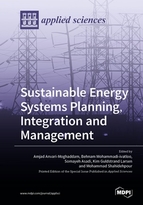Sustainable Energy Systems Planning, Integration and Management
A special issue of Applied Sciences (ISSN 2076-3417). This special issue belongs to the section "Energy Science and Technology".
Deadline for manuscript submissions: closed (31 July 2019) | Viewed by 47374
Special Issue Editors
Interests: power system operation and planning; microgrids and active energy networks; energy markets and analytics; operations research and its applications to energy systems
Special Issues, Collections and Topics in MDPI journals
Interests: smart energy systems, machine learning, uncertainty management, decision making, renewable energy sources
Special Issues, Collections and Topics in MDPI journals
Interests: design of energy efficient buildings; smart grid; food–water–energy nexus; integrate advanced–sustainable materials and nanomaterials; life cycle assessment
Special Issues, Collections and Topics in MDPI journals
Interests: embedded systems; computational sustainability; socio-technical systems in ICT; energy timed automata
Interests: energy systems operation and planning; microgrids; energy hubs; sustainable energy integration
Special Issues, Collections and Topics in MDPI journals
Special Issue Information
Dear Colleagues,
Energy systems worldwide are undergoing a major transformation as a consequence of the transition towards the widespread use of clean and sustainable energy sources. Basically, this involves massive changes in technical and organizational levels together with tremendous technological upgrades in different sectors ranging from the energy generation and transmission systems down to the distribution systems. These actions constitute a huge science and engineering challenges and demands for expert knowledge in the field to create solutions for a sustainable energy system that is economically, environmentally and socially viable, while meeting high security requirements.
This Special Issue will cover these promising and dynamic areas of research and development and will allow the gathering of contributions in sustainable energy systems planning, integration and management. This Special Issue also seeks papers to report advances on any aspect of these developments. Manuscripts should be unpublished and report significant advancements.
Dr. Amjad Anvari-Moghaddam
Dr. Behnam Mohammadi-ivatloo
Dr. Somayeh Asadi
Prof. Dr. Kim Guldstrand Larsen
Prof. Dr. Mohammad Shahidehpour
Guest Editors
Manuscript Submission Information
Manuscripts should be submitted online at www.mdpi.com by registering and logging in to this website. Once you are registered, click here to go to the submission form. Manuscripts can be submitted until the deadline. All submissions that pass pre-check are peer-reviewed. Accepted papers will be published continuously in the journal (as soon as accepted) and will be listed together on the special issue website. Research articles, review articles as well as short communications are invited. For planned papers, a title and short abstract (about 100 words) can be sent to the Editorial Office for announcement on this website.
Submitted manuscripts should not have been published previously, nor be under consideration for publication elsewhere (except conference proceedings papers). All manuscripts are thoroughly refereed through a single-blind peer-review process. A guide for authors and other relevant information for submission of manuscripts is available on the Instructions for Authors page. Applied Sciences is an international peer-reviewed open access semimonthly journal published by MDPI.
Please visit the Instructions for Authors page before submitting a manuscript. The Article Processing Charge (APC) for publication in this open access journal is 2400 CHF (Swiss Francs). Submitted papers should be well formatted and use good English. Authors may use MDPI's English editing service prior to publication or during author revisions.
Keywords
- Renewable energy-based generation systems
- Sustainable energy integration especially for dispersed and small capacity sources or even small networks (e.g., microgrids)
- Micro- and nano-energy systems and technologies
- Dynamic optimization with uncertainly in sustainable energy systems
- Optimal operations and control of sustainable energy systems
- Innovative perspectives on systems of sustainable consumption and production
- Economic and environment friendly dispatch with renewables
- Energy harvesting
- Intelligent methods in sustainable power and energy systems
- Real-time emissions and environmental impact analysis
- Zero waste
- Energy efficient and zero energy buildings
- Sustainability metrics in energy systems
- Sustainable computing systems and applications
- Energy conversion, conservation and management
- Hybrid/combined/integrated energy systems for multi-generation
- Energy systems modelling for sustainable planning
- Energy efficiency and technology
- Sustainable/Green energy
- Design and development of sustainable energy supply systems
- Multi-energy systems










